Enhancing Corrosion and Wear Resistance of Ti6Al4V Alloy Using CNTs Mixed Electro-Discharge Process
Abstract
1. Introduction
Related Work
2. Material and Methods
2.1. Material
2.2. Experimental Work
2.3. Measurement and Calculations of Output Responses
2.4. Surface Characterization of EDT specimen
2.5. Examination of Wear and Electrochemical Corrosion Behavior
- CR is in mm/year,
- icorr is in µA/cm2;
- K = 3.27 × 10−3, mm g/µA cm year;
- = density in g/cm3;
- EW = equivalent weight of the material.
3. Results and Discussion
3.1. Evaluation of the Output Responses
- ‘η’ denotes the SN ratio (dB);
- ‘yi’ indicates the value of ith trial of experimental trial;
- ‘n’ is the repetition of the experiment.
3.1.1. Analysis of Microhardness
3.1.2. Analysis of Surface Roughness
3.2. Morphology and Phase Composition Analysis of MWCNTs Treated Specimen
3.3. In-Vitro Wear and Corrosion Analysis of EDT Samples
4. Conclusions
Author Contributions
Funding
Conflicts of Interest
References
- Aleksandra, W.B.; Ewa, S.Z.; Wojciech, P.; Elzbieta, D.; Aleksandra, B.; Marta, B. A model of adsorption of albumin on the implant surface titanium and titanium modified carbon coatings (MWCNT-EPD) 2D correlation analysis. J. Mol. Struct. 2016, 1124, 61–70. [Google Scholar] [CrossRef]
- Singh, G.; Sidhu, S.S.; Bains, P.S.; Singh, M.; Bhui, A.S. On surface modification of Ti alloy by electro discharge coating using hydroxyapatite powder mixed dielectric with graphite tool. J. Bio- Tribo-Corros. 2020, 6, 91. [Google Scholar] [CrossRef]
- Aliyu, A.A.; Abdul-Rani, A.M.; Ginta, T.L.; Rao, T.V.V.L.N.; Axinte, E.; Ali, S.; Ramli, M. Hydroxyapatite electro discharge coating of Zr-based bulk metallic glass for potential orthopedic applications. Key Eng. Mater. 2019, 796, 123–128. [Google Scholar] [CrossRef]
- Liu, X.; Chu, P.K.; Ding, C. Surface modification of titanium, titanium alloys, and related materials for biomedical applications. J. Mater. Sci. Eng. R. 2005, 47, 49–121. [Google Scholar] [CrossRef]
- Wang, Z.L.; Fang, Y.; Wu, P.N.; Zhao, W.S.; Cheng, K. Surface modification process by electric discharge machining with a Ti powder green compact electrode. J. Mater. Process. Technol. 2002, 129, 139–142. [Google Scholar] [CrossRef]
- Bui, V.D.; Mwangi, J.W.; Schubert, A. Powder mixed electrical discharge machining for antibacterial coating on titanium implant surfaces. J. Manuf. Process. 2019, 44, 261–270. [Google Scholar] [CrossRef]
- Al-Amin, M.; Abdul-Rani, A.M.; Abdu-Aliyu, A.A.; Abdul-Razak, M.A.; Hastuty, S.; Bryant, M.G. Powder mixed-EDM for potential biomedical applications: A critical review. Mater. Manuf. Process. 2020, 1–23. [Google Scholar] [CrossRef]
- Umar-Farooq, M.; Pervez-Mughal, M.; Ahmed, N.; Ahmad-Mufti, N.; Al-Ahmari, A.M.; He, Y. On the investigation of surface integrity of Ti6Al4V ELI using Si-mixed electric discharge machining. Materials 2020, 13, 1549. [Google Scholar] [CrossRef]
- Kumar, V.; Diyaley, S.; Chakraborty, S. Teaching-learning-based parametric optimization of an electrical discharge machining process. FU Ser. Mech. Eng. 2020, 18, 281–300. [Google Scholar] [CrossRef]
- Tzeng, Y.F.; Lee, C.Y. Effects of powder characteristics on electro discharge machining efficiency. Int. J. Adv. Manuf. Technol. 2001, 17, 586–592. [Google Scholar] [CrossRef]
- Furutania, K.; Saneto, A.; Takezawa, H.; Mohri, N.; Miyake, H. Accretion of titanium carbide by electrical discharge machining with powder suspended in working fluid. Prec. Eng. 2001, 25, 138–144. [Google Scholar] [CrossRef]
- Singh, G.; Lamichhane, Y.; Bhui, A.S.; Sidhu, S.S.; Bains, P.S.; Mukhiya, P. Surface morphology and microhardness behavior of 316L in HAp-PMEDM. FU Ser. Mech. Eng. 2019, 17, 445–454. [Google Scholar] [CrossRef]
- Al-Amin, M.; Abdul-Rani, A.M.; Abdu-Aliyu, A.A.; Bryant, M.G.; Danish, M.; Ahmad, A. Bio-ceramic coatings adhesion and roughness of biomaterials through PM-EDM: A comprehensive review. Mater. Manuf. Process. 2020, 35, 1157–1180. [Google Scholar] [CrossRef]
- Moro, T.; Mohri, N.; Otsubo, H.; Goto, A.; Saito, N. Study on the surface modification system with electrical discharge machine in the practical usage. J. Mater. Process. Technol. 2004, 149, 65–70. [Google Scholar] [CrossRef]
- Abdudeen, A.; Abu-Qudeiri, J.E.; Kareem, A.; Ahammed, T.; Ziout, A. Recent advances and perceptive insights into powder-mixed dielectric fluid of EDM. Micromachines 2020, 11, 754. [Google Scholar] [CrossRef]
- Harris, P.J. Carbon nanotubes and related structures: New materials for the twenty-first century. Am. J. Phys. 2004, 72, 414–415. [Google Scholar] [CrossRef]
- George, G.; Sisupal, S.B.; Tomy, T.; Kumaran, A.; Vadivelu, P.; Suvekbala, V.; Sivaram, S.; Ragupathy, L. Facile, environmentally benign and scalable approach to produce pristine few layers graphene suitable for preparing biocompatible polymer nanocomposites. Sci. Rep. 2018, 8, 11228. [Google Scholar] [CrossRef]
- Kumar, S.; Parekh, S.H. Linking graphene-based material physicochemical properties with molecular adsorption, structure and cell fate. Commun. Chem. 2020, 3, 8. [Google Scholar] [CrossRef]
- Han, Z.J.; Rider, A.E.; Fisher, C.; Van-der-Laan, T.; Kumar, S.; Levchenko, I.; Ostrikov, K. Biological Application of Carbon Nanotubes and Graphene. In Carbon Nanotubes and Graphene, 2nd ed.; Tanaka, K., Iijima, S., Eds.; Elsevier: Amsterdam, The Netherlands, 2014; pp. 279–312. [Google Scholar] [CrossRef]
- Wang, W.; Yokoyama, A.; Liao, S.; Omori, M.; Zhu, Y.; Uo, M.; Akasaka, T.; Watari, F. Preparation and characteristics of a binderless carbon nanotube monolith and its biocompatibility. Mater. Sci. Eng. C. 2008, 28, 1082–1086. [Google Scholar] [CrossRef]
- Sarraf, M.; Razak, B.A.; Nasiri-Tabrizi, B.; Dabbagh, A.; Kasim, N.H.A.; Basirun, W.J.; Bin-Sulaiman, E. Nanomechanical properties, wear resistance and in-vitro characterization of Ta2O5 nanotubes coating on biomedical grade Ti-6Al-4V. J. Mech. Behav. Biomed. Mater. 2017, 66, 159–171. [Google Scholar] [CrossRef]
- Li, J.; He, X.; Zhang, G.; Hang, R.; Huang, X.; Tang, B.; Zhang, X. Electrochemical corrosion, wear and cell behavior of ZrO2/TiO2 alloyed layer on Ti-6Al-4V. Bioelectrochemistry 2018, 121, 105–114. [Google Scholar] [CrossRef] [PubMed]
- Pogrebnjak, A.D.; Bratushka, S.N.; Uglov, V.V.; Rusakov, V.S.; Beresnev, V.M.; Anischik, V.M.; Malikov, L.V.; Levintant, N.; Zukovski, P. Structures and properties of Ti alloys after double implantation. Vacuum 2009, 83, S240–S244. [Google Scholar] [CrossRef]
- Man, H.C.; Bai, N.; Cheng, F.T. Laser diffusion nitriding of Ti-6Al-4V for improving hardness and wear resistance. Appl. Surf. Sci. 2011, 258, 436–441. [Google Scholar] [CrossRef]
- Kgoete, F.M.; Popoola, A.P.I.; Fayomi, O.S.I. Influence of spark plasma sintering on microstructure and corrosion behaviour of Ti-6Al-4V alloy reinforced with micron-sized Si3N4 powder. Defence Technol. 2018, 14, 403–407. [Google Scholar] [CrossRef]
- Devgan, S.; Sidhu, S.S. Evolution of surface modification trends in bone related biomaterials: A review. Mater. Chem. Phys. 2019, 223, 68–78. [Google Scholar] [CrossRef]
- Li, X.; Liu, X.; Huang, J.; Fan, Y.; Cui, F.-Z. Biomedical investigation of CNT based coatings. Surf. Coat. Technol. 2011, 206, 759–766. [Google Scholar] [CrossRef]
- Deng, J.; Pang, S.; Wang, C.; Ren, T. Biotribological properties of Ti-6Al-4V alloy treated with self-assembly multi-walled carbon nanotube coating. Surf. Coat. Technol. 2020, 382, 125159. [Google Scholar] [CrossRef]
- Terada, M.; Abe, S.; Akasaka, T.; Uo, M.; Kitagawa, Y.; Watari, F. Multiwalled carbon nanotube coating on titanium. Biomed. Mater. Eng. 2009, 19, 45–52. [Google Scholar] [CrossRef]
- Bains, P.S.; Singh, G.; Bhui, A.S.; Sidhu, S.S. Parametric evaluation of medical grade titanium alloy in MWCNTs mixed dielectric using graphite electrode. In Biomaterials in Orthopaedics and Bone Regeneration, Materials Horizons: From Nature to Nanomaterials, 1st ed.; Bains, P., Ed.; Springer: Singapore, 2019; pp. 1–14. [Google Scholar] [CrossRef]
- Buser, D.; Schenk, R.K.; Steinemann, S.; Fiorellini, J.P.; Fox, C.H.; Stich, H. Influence of surface characteristics on bone integration of titanium implants. A histomorphometric study in miniature pigs. J. Biomed. Mater. Res. 1991, 25, 889–902. [Google Scholar] [CrossRef]
- Larsson, C.; Thomsen, P.; Aronsson, B.O.; Rodahl, M.; Lausmaa, J.; Kasemo, B.; Ericson, L.E. Bone response to surface-modified titanium implants: Studies on the early tissue response to machined and electropolished implants with different oxide thicknesses. Biomaterials 1996, 17, 605–616. [Google Scholar] [CrossRef]
- Mour, M.; Das, D.; Winkler, T.; Hoenig, E.; Mielke, G.; Morlock, M.M.; Schilling, A.F. Advances in Porous Biomaterials for Dental and Orthopaedic Applications. Materials 2010, 3, 2947–2974. [Google Scholar] [CrossRef]
- ASTM G102-89, Standard Practice for Calculation of Corrosion Rates and Related Information from Electrochemical Measurements; ASTM Int.: West Conshohocken, PA, USA, 2015. [CrossRef]
- Gill, A.S.; Kumar, S. Surface Roughness and Microhardness Evaluation for EDM with Cu–Mn Powder Metallurgy Tool. Mater. Manuf. Process. 2015, 31, 514–521. [Google Scholar] [CrossRef]
- Singh, G.; Sidhu, S.S.; Bains, P.S.; Bhui, A.S. Improving microhardness and wear resistance of 316L by TiO2 powder mixed electro-discharge treatment. Mater. Res. Express. 2019, 6, 086501. [Google Scholar] [CrossRef]
- Zain, Z.M.; Ndaliman, M.B.; Khan, A.A.; Ali, M.Y. Improving micro-hardness of stainless steel through powder-mixed electrical discharge machining. Proc. IMechE Part C J. Mech. Eng. Sci. 2014, 228, 3374–3380. [Google Scholar] [CrossRef]
- Batish, A.; Bhattacharya, A. Mechanism of material deposition from powder, electrode and dielectric for surface modification of H11 and H13 die steels in EDM process. Mater. Sci. Forum. 2012, 701, 61–75. [Google Scholar] [CrossRef]
- Kumar, A.; Maheshwari, S.; Sharma, C.; Beri, N. Analysis of machining characteristics in additive mixed electric discharge machining of nickel-based super alloy Inconel 718. Mater. Manuf. Process. 2011, 26, 1011–1018. [Google Scholar] [CrossRef]
- Melentiev, R.; Kang, C.; Shen, G.; Fang, F. Study on surface roughness generated by micro-blasting on Co-Cr-Mo bio-implant. Wear 2019, 428–429, 111–126. [Google Scholar] [CrossRef]
- Rao, S.; Hashemiastaneh, S.; Villanueva, J.; Silva, F.; Takoudis, C.; Bijukumar, D.; Souza, J.C.M.; Mathew, M.T. In vitro osseointegration analysis of bio-functionalized titanium samples in a protein-rich medium. J. Mech. Behav. Biomed. Mater. 2019, 96, 152–164. [Google Scholar] [CrossRef]
- Ryan, G.; Pandit, A.; Apatsidis, D. Fabrication methods of porous metals for use in orthopaedic applications. Biomaterials 2006, 27, 2651–2670. [Google Scholar] [CrossRef]
- Zhu, X.; Chen, J.; Scheideler, L.; Altebaeumer, T.; Geis-Gerstorfer, J.; Kern, D. Cellular reactions of osteoblasts to micron- and submicron-scale porous structures of titanium surfaces. Cells Tissues Organs 2004, 178, 13–22. [Google Scholar] [CrossRef]
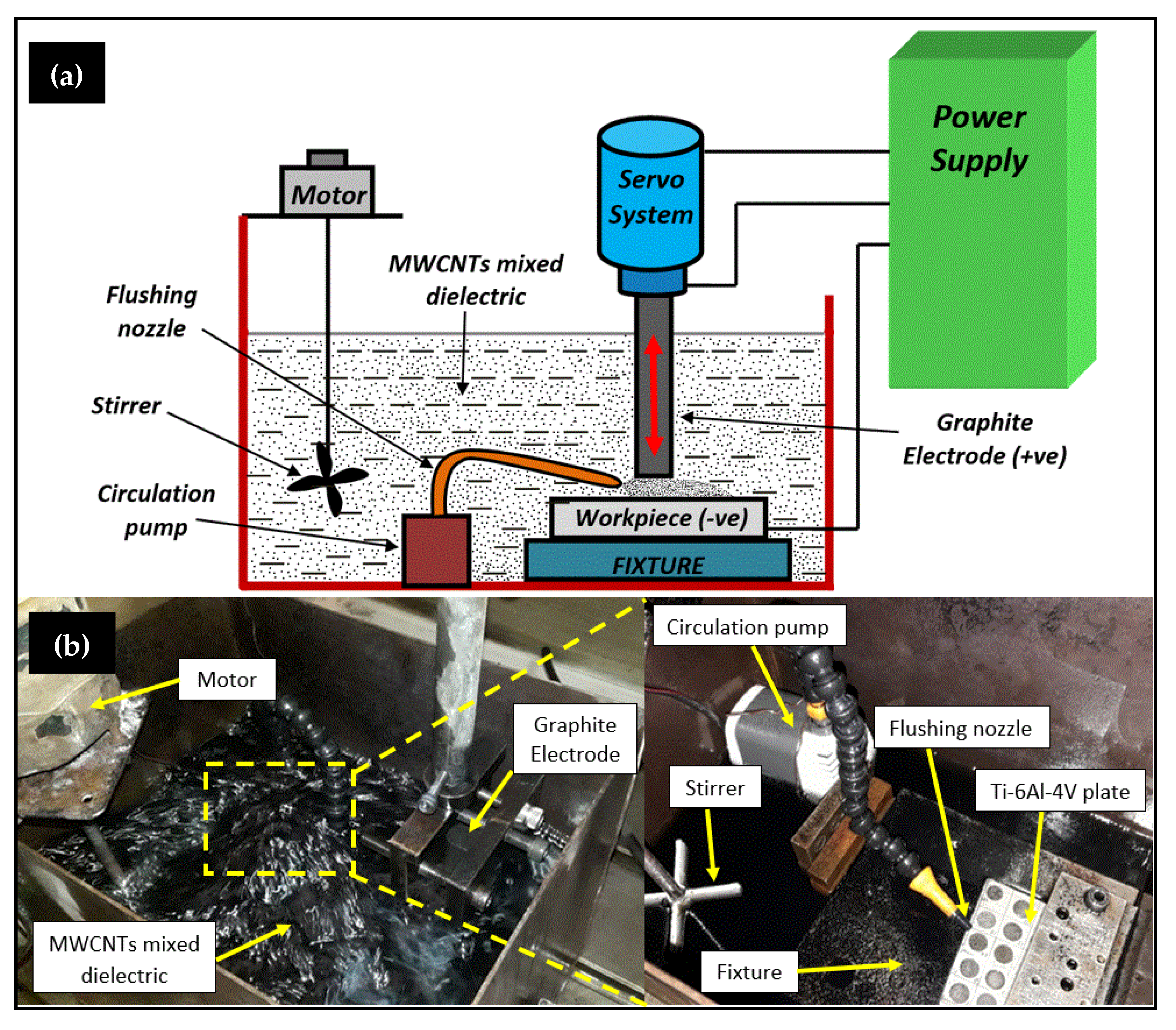

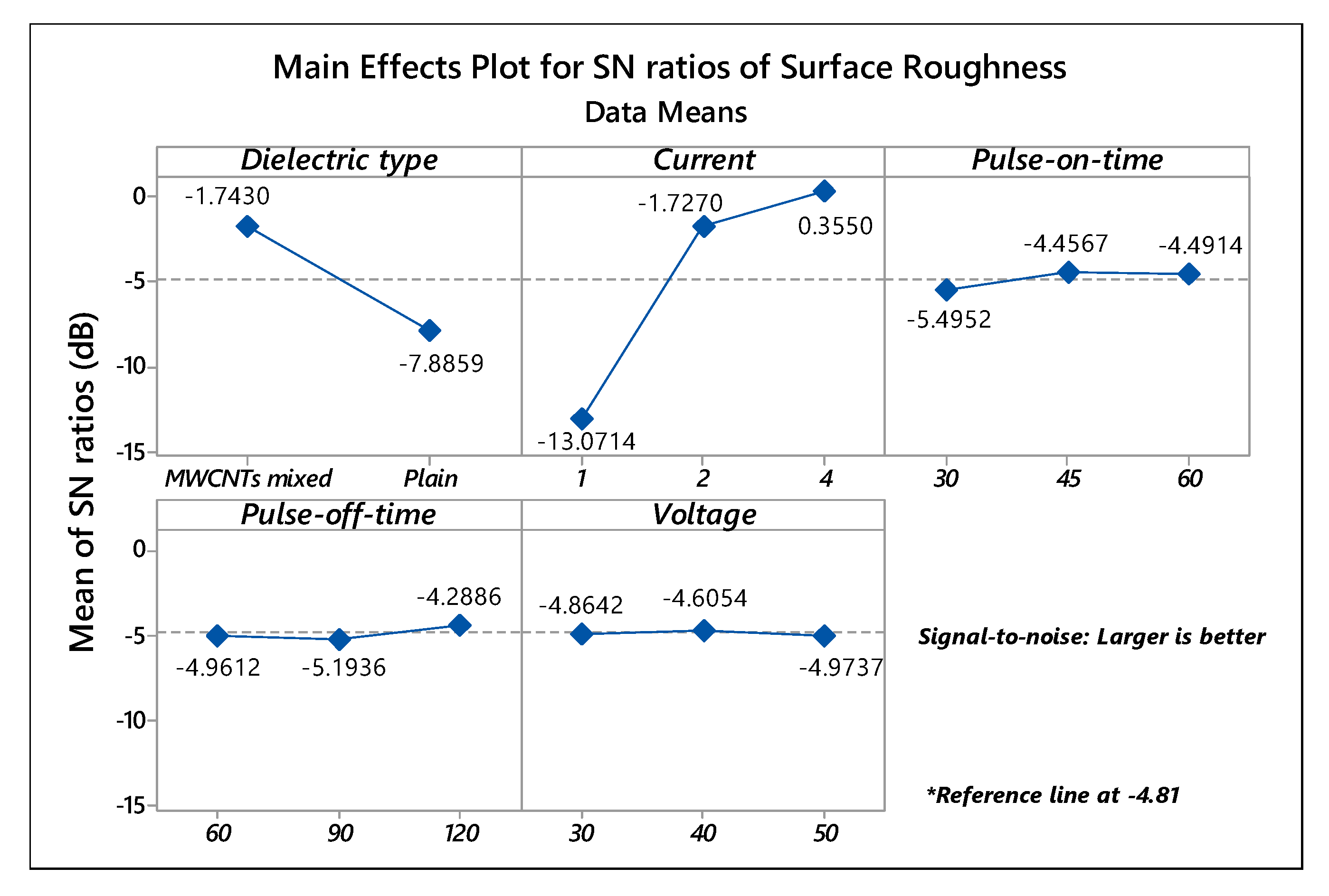

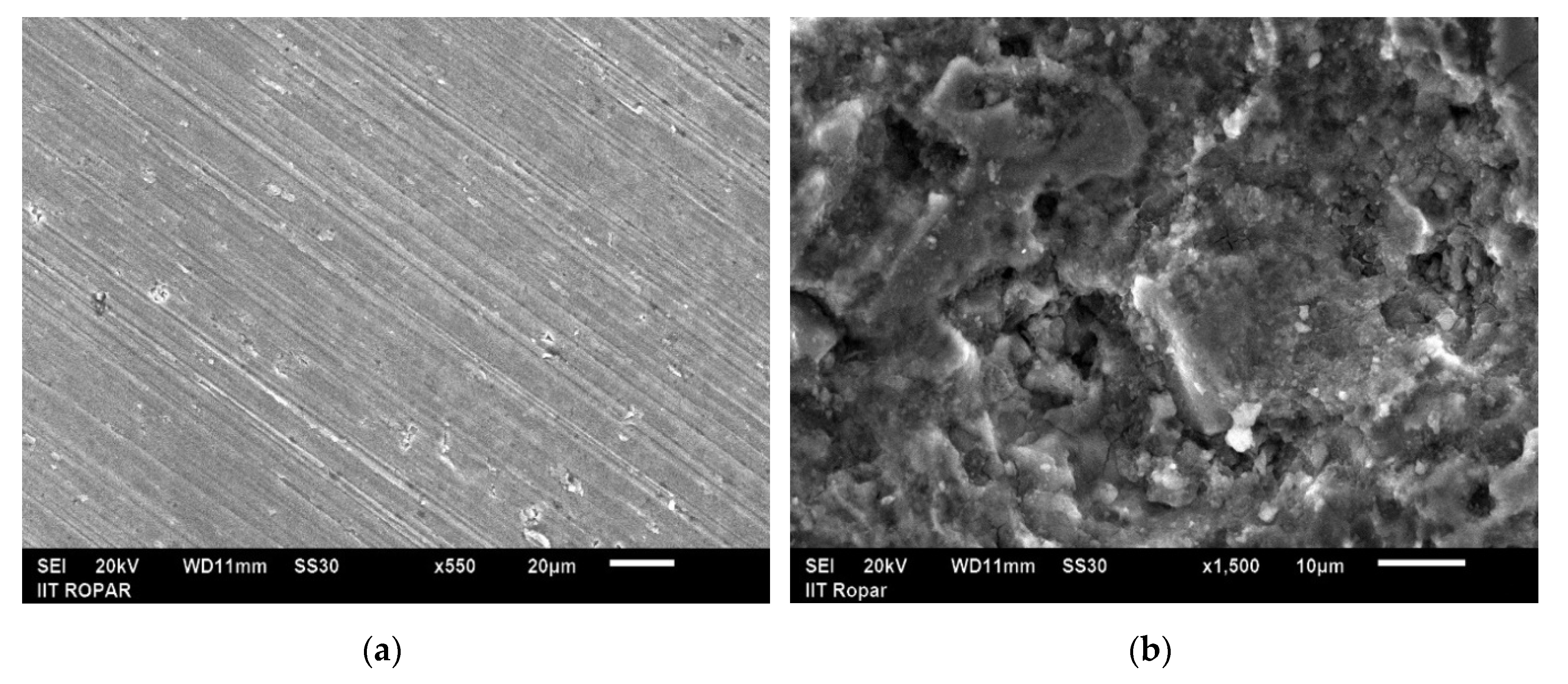
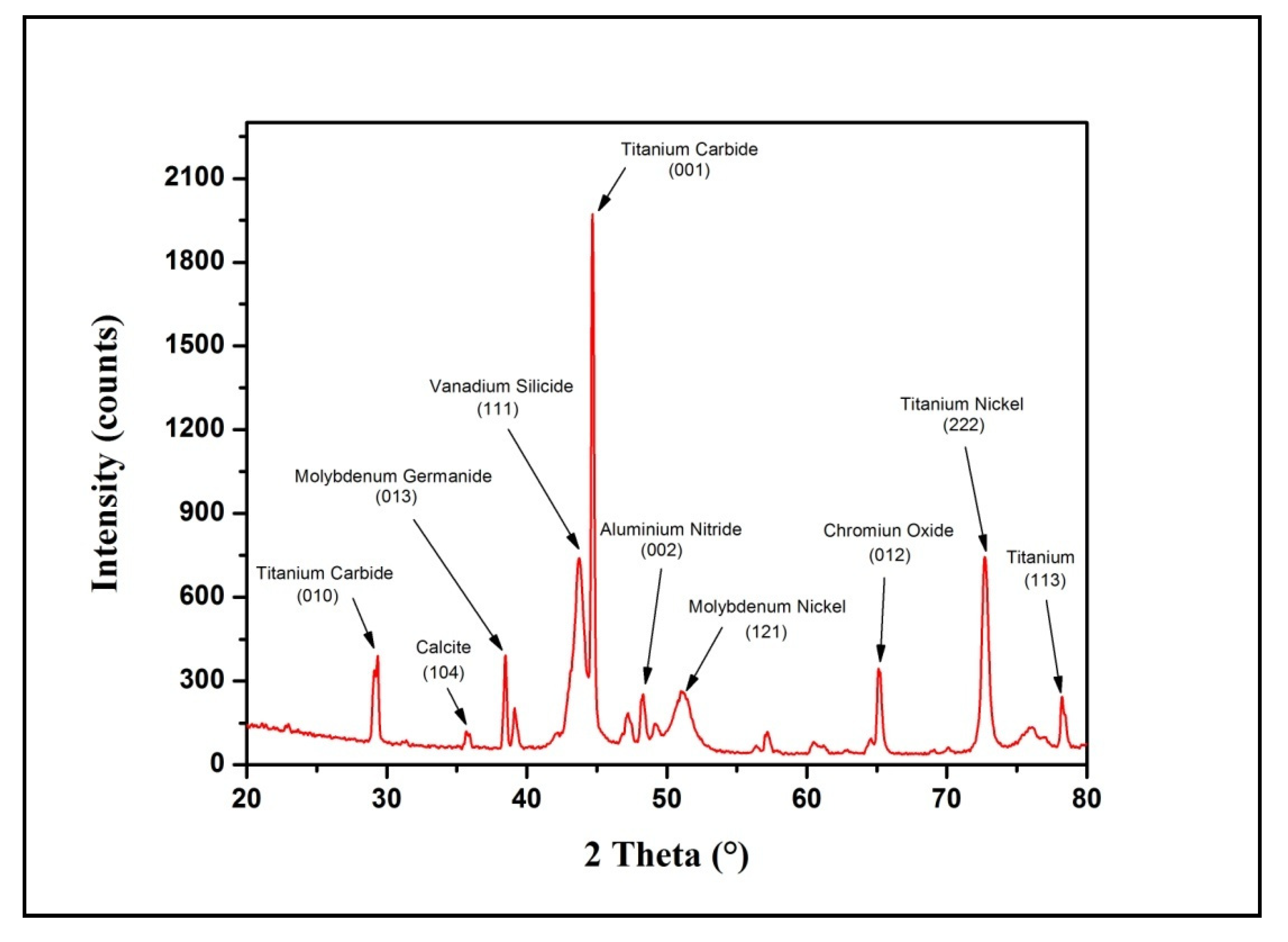
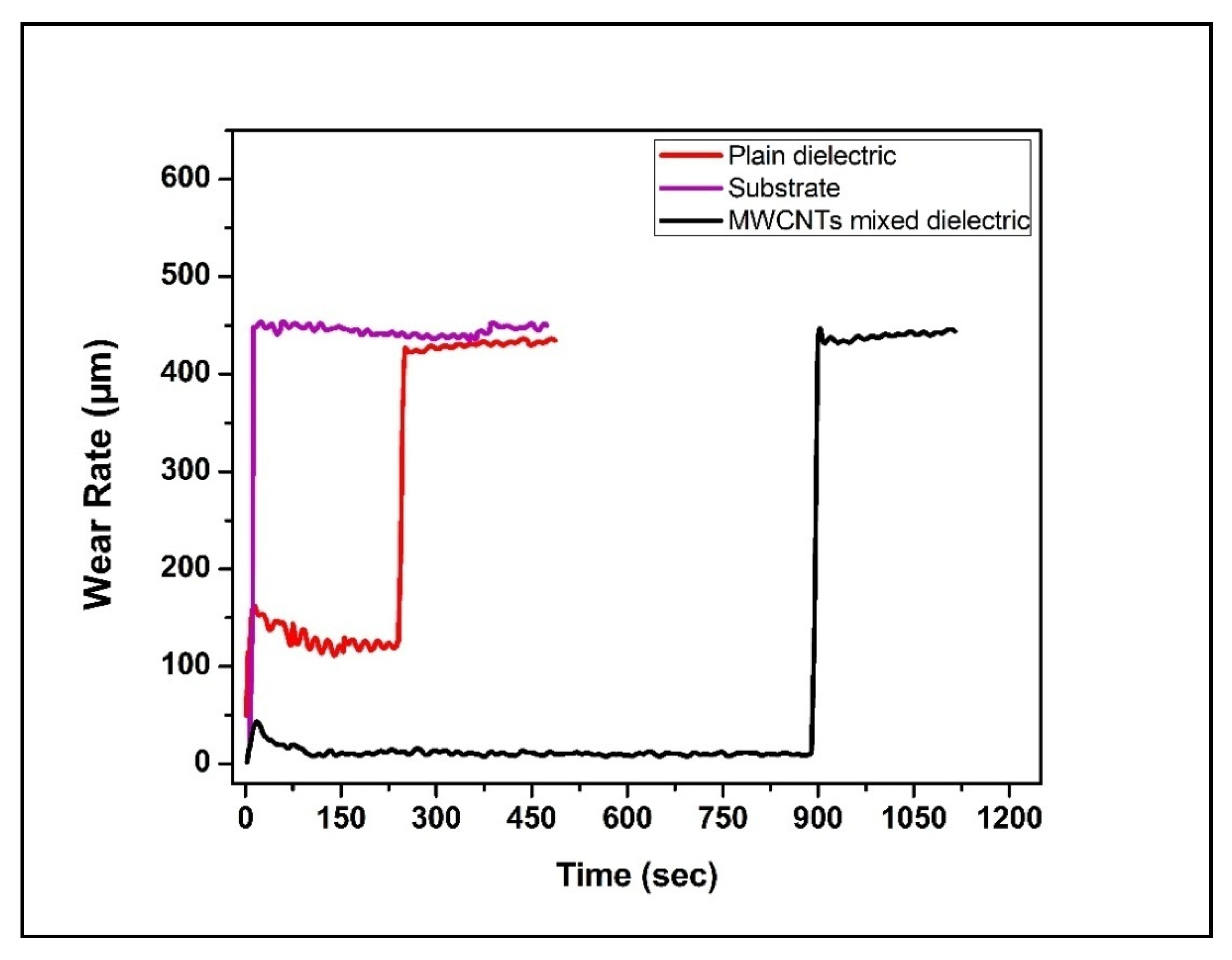
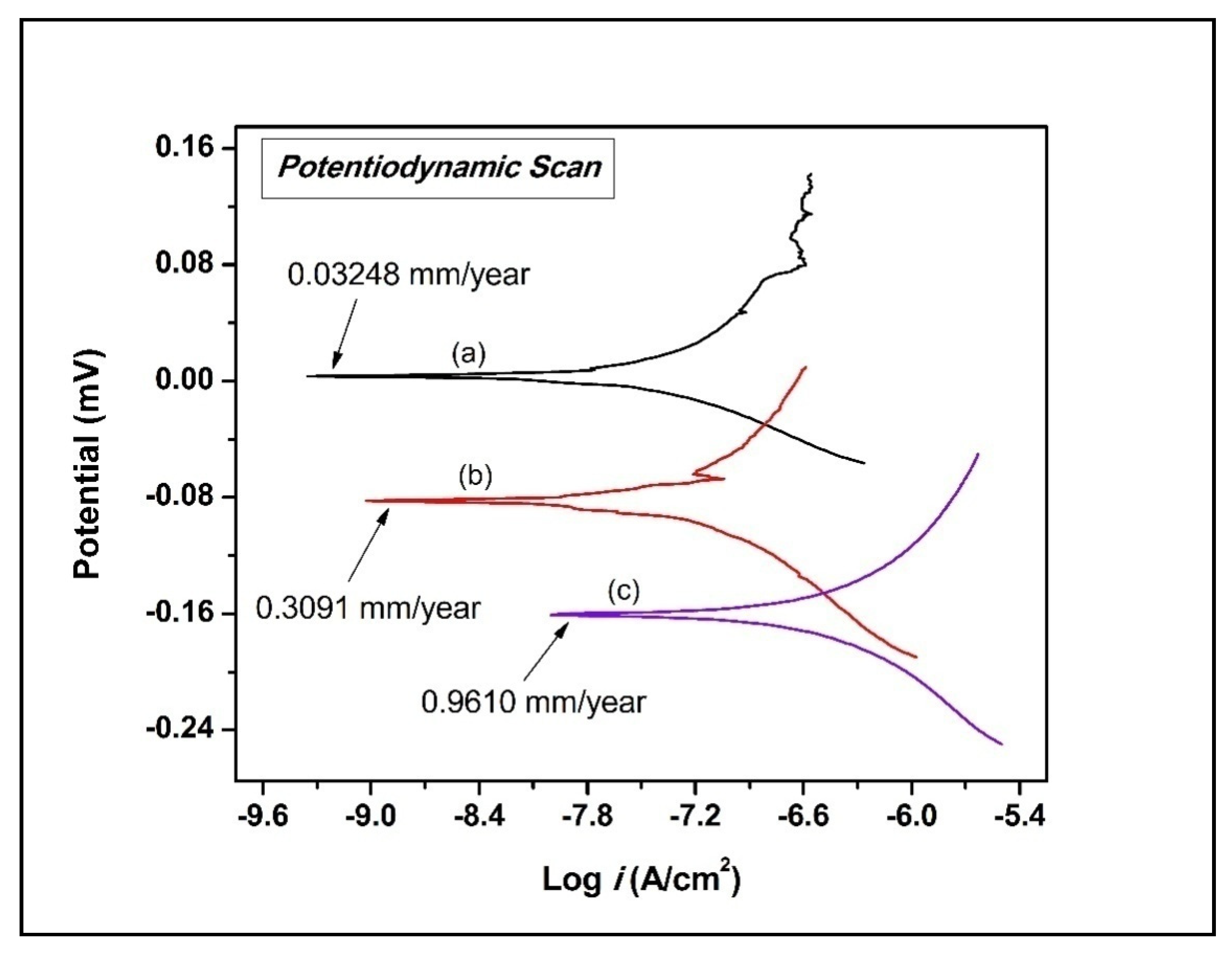
| Property | Ti-6Al-4V | Graphite |
|---|---|---|
| Chemical composition | Ti: 89.54%; Al: 6.1%; V: 4.2%; Fe: 0.09%; C: 0.03%; O: 0.03%; N: 0.003%; H: 0.001% | Pure carbon |
| Size (mm) | 70 × 70 × 5 | Ø 9.5 |
| Density (g/cm3) | 4.43 | 2.26 |
| Melting temperature (°C) | 1604–1660 | 3650 |
| Thermal conductivity (W/m.K) | 6.70 | 24.0 |
| Specific heat (J/Kg °C) | 526.3 | 0.7077 |
| Electrical resistivity (Ω cm) | 1.78 × 10−4 | 6.0 × 10−3 |
| Property | Description |
|---|---|
| Production Method | Chemical Vapor Deposition |
| Available form | Black powder |
| Diameter | Outer Diameter: 10–30 nm |
| Length | 10 microns |
| Nanotubes purity | >95% |
| Metal particles | <4% |
| Amorphous carbon | <1% |
| Specific surface area | 330 m2/g |
| Bulk density | 0.04–0.06 g/cm3 |
| Parameter | Symbol | Units | Levels | ||
|---|---|---|---|---|---|
| Level 1 | Level 2 | Level 3 | |||
| Dielectric type | A | – | Plain dielectric | MWCNTs mixed dielectric | – |
| Current | B | ampere | 1 | 2 | 4 |
| Pulse-on time | C | µ-seconds | 30 | 45 | 60 |
| Pulse-off time | D | µ-seconds | 60 | 90 | 120 |
| Voltage | E | volts | 30 | 40 | 50 |
| Exp. Trial | Levels of Process Parameters | Actual Values of Process Parameters | ||||||||
|---|---|---|---|---|---|---|---|---|---|---|
| A | B | C | D | E | A | B | C | D | E | |
| 1. | 1 | 1 | 1 | 1 | 1 | Plain dielectric | 1 | 30 | 60 | 30 |
| 2. | 1 | 1 | 2 | 2 | 2 | Plain dielectric | 1 | 45 | 90 | 40 |
| 3. | 1 | 1 | 3 | 3 | 3 | Plain dielectric | 1 | 60 | 120 | 50 |
| 4. | 1 | 2 | 1 | 1 | 2 | Plain dielectric | 2 | 30 | 60 | 40 |
| 5. | 1 | 2 | 2 | 2 | 3 | Plain dielectric | 2 | 45 | 90 | 50 |
| 6. | 1 | 2 | 3 | 3 | 1 | Plain dielectric | 2 | 60 | 120 | 30 |
| 7. | 1 | 3 | 1 | 2 | 1 | Plain dielectric | 4 | 30 | 90 | 30 |
| 8. | 1 | 3 | 2 | 3 | 2 | Plain dielectric | 4 | 45 | 120 | 40 |
| 9. | 1 | 3 | 3 | 1 | 3 | Plain dielectric | 4 | 60 | 60 | 50 |
| 10. | 2 | 1 | 1 | 3 | 3 | MWCNTs mixed dielectric | 1 | 30 | 120 | 50 |
| 11. | 2 | 1 | 2 | 1 | 1 | MWCNTs mixed dielectric | 1 | 45 | 60 | 30 |
| 12. | 2 | 1 | 3 | 2 | 2 | MWCNTs mixed dielectric | 1 | 60 | 90 | 40 |
| 13. | 2 | 2 | 1 | 2 | 3 | MWCNTs mixed dielectric | 2 | 30 | 90 | 50 |
| 14. | 2 | 2 | 2 | 3 | 1 | MWCNTs mixed dielectric | 2 | 45 | 120 | 30 |
| 15. | 2 | 2 | 3 | 1 | 2 | MWCNTs mixed dielectric | 2 | 60 | 60 | 40 |
| 16. | 2 | 3 | 1 | 3 | 2 | MWCNTs mixed dielectric | 4 | 30 | 120 | 40 |
| 17. | 2 | 3 | 2 | 1 | 3 | MWCNTs mixed dielectric | 4 | 45 | 60 | 50 |
| 18. | 2 | 3 | 3 | 2 | 1 | MWCNTs mixed dielectric | 4 | 60 | 90 | 30 |
| Exp. Trial | Output Responses | SN Ratio, dB | ||||||
|---|---|---|---|---|---|---|---|---|
| MH (HV) | SR (µm) | MH | SR | |||||
| Rep 1 | Rep 2 | Rep 3 | Rep 1 | Rep 2 | Rep 3 | |||
| 1. | 897.8 | 937.0 | 925.7 | 0.053 | 0.061 | 0.087 | 59.2731 | −24.0190 |
| 2. | 1066.5 | 929.3 | 1025.7 | 0.138 | 0.094 | 0.105 | 60.0179 | −19.3177 |
| 3. | 1177.4 | 1098.1 | 1109.8 | 0.106 | 0.101 | 0.119 | 61.0373 | −19.3390 |
| 4. | 1091.9 | 1287.0 | 1259.3 | 0.802 | 0.657 | 0.883 | 61.6051 | −2.3502 |
| 5. | 1484.3 | 1561.2 | 1586.0 | 0.661 | 0.794 | 0.675 | 63.7615 | −3.0605 |
| 6. | 1497.0 | 1434.7 | 1205.9 | 0.698 | 1.021 | 0.976 | 62.6768 | −1.3158 |
| 7. | 1419.8 | 1459.2 | 1384.3 | 0.959 | 1.014 | 1.018 | 63.0465 | −0.0358 |
| 8. | 1736.8 | 1689.1 | 1656.5 | 0.855 | 0.954 | 0.969 | 64.5740 | −0.7086 |
| 9. | 1748.3 | 1761.2 | 1786.0 | 0.897 | 0.892 | 0.941 | 64.9347 | -0.8266 |
| 10. | 2140.5 | 2362.8 | 2306.1 | 0.523 | 0.591 | 0.615 | 67.0966 | −4.8491 |
| 11. | 2705.1 | 2653.1 | 3067.4 | 0.534 | 0.698 | 0.686 | 68.9165 | −4.0849 |
| 12. | 2901.8 | 3242.1 | 3263.2 | 0.412 | 0.469 | 0.501 | 69.8885 | −6.8189 |
| 13. | 3147.0 | 3242.9 | 3171.3 | 0.676 | 0.733 | 0.709 | 70.0657 | −3.0383 |
| 14. | 2890.0 | 2982.9 | 3329.9 | 0.885 | 0.974 | 0.874 | 69.6885 | −0.8398 |
| 15. | 3488.2 | 3792.7 | 3524.3 | 1.118 | 0.980 | 1.002 | 71.1123 | 0.2422 |
| 16. | 4530.9 | 4346.8 | 4306.0 | 0.991 | 1.322 | 1.267 | 72.8520 | 1.3207 |
| 17. | 4394.0 | 4494.0 | 4469.6 | 1.527 | 0.913 | 1.280 | 72.9709 | 1.2709 |
| 18. | 3979.4 | 4283.0 | 4293.2 | 1.248 | 1.226 | 0.992 | 72.4180 | 1.1097 |
| Source | DF | Seq SS | Adj MS | F-Value | p-Value | % Contribution |
|---|---|---|---|---|---|---|
| Dielectric type | 1 | 304.897 | 304.897 | 571.58 | 0.000 * | 83.019 |
| Current | 2 | 50.309 | 25.155 | 47.16 | 0.010 * | 13.698 |
| Pulse-on-time | 2 | 5.919 | 2.959 | 5.55 | 0.031 * | 1.612 |
| Pulse-off-time | 2 | 0.142 | 0.071 | 0.13 | 0.877 | 0.038 |
| Voltage | 2 | 1.727 | 0.863 | 1.62 | 0.257 | 0.472 |
| Residual error | 8 | 4.267 | 0.533 | 1.161 | ||
| Total | 17 | 367.261 | 100 |
| Source | DF | Seq SS | Adj MS | F-Value | p-Value | % Contribution |
|---|---|---|---|---|---|---|
| Dielectric type | 1 | 169.81 | 169.806 | 53.88 | 0.000 * | 16.551 |
| Current | 2 | 626.60 | 313.299 | 99.41 | 0.000 * | 61.076 |
| Pulse-on-time | 2 | 4.18 | 2.088 | 0.66 | 0.550 | 0.407 |
| Pulse-off-time | 2 | 2.65 | 1.325 | 0.42 | 0.675 | 0.258 |
| Voltage | 2 | 0.43 | 0.215 | 0.07 | 0.935 | 0.041 |
| Dielectric type × current | 2 | 203.38 | 101.689 | 32.27 | 0.001 * | 19.824 |
| Residual error | 6 | 18.91 | 3.151 | 1.843 | ||
| Total | 17 | 1025.95 | 100 |
| Sr. No. | Sample | Ecorr (mV) | icorr (µA/cm2) | βa (mV/dec) | βc (mV/dec) | Corrosion Rate (mm/y) | Protection Efficiency (Pe) |
|---|---|---|---|---|---|---|---|
| 1. | MWCNTs mixed dielectric | 3.50860 | 1.83 | 93.1230 | 187.420 | 0.03248 | 96.63% |
| 2. | Plain dielectric | −82.4920 | 17.48 | 211.820 | 126.560 | 0.3091 | 67.83% |
| 3. | Substrate | −160.640 | 54.35 | 234.610 | 292.470 | 0.9610 | – |
© 2020 by the authors. Licensee MDPI, Basel, Switzerland. This article is an open access article distributed under the terms and conditions of the Creative Commons Attribution (CC BY) license (http://creativecommons.org/licenses/by/4.0/).
Share and Cite
Singh, G.; Ablyaz, T.R.; Shlykov, E.S.; Muratov, K.R.; Bhui, A.S.; Sidhu, S.S. Enhancing Corrosion and Wear Resistance of Ti6Al4V Alloy Using CNTs Mixed Electro-Discharge Process. Micromachines 2020, 11, 850. https://doi.org/10.3390/mi11090850
Singh G, Ablyaz TR, Shlykov ES, Muratov KR, Bhui AS, Sidhu SS. Enhancing Corrosion and Wear Resistance of Ti6Al4V Alloy Using CNTs Mixed Electro-Discharge Process. Micromachines. 2020; 11(9):850. https://doi.org/10.3390/mi11090850
Chicago/Turabian StyleSingh, Gurpreet, Timur Rizovich Ablyaz, Evgeny Sergeevich Shlykov, Karim Ravilevich Muratov, Amandeep Singh Bhui, and Sarabjeet Singh Sidhu. 2020. "Enhancing Corrosion and Wear Resistance of Ti6Al4V Alloy Using CNTs Mixed Electro-Discharge Process" Micromachines 11, no. 9: 850. https://doi.org/10.3390/mi11090850
APA StyleSingh, G., Ablyaz, T. R., Shlykov, E. S., Muratov, K. R., Bhui, A. S., & Sidhu, S. S. (2020). Enhancing Corrosion and Wear Resistance of Ti6Al4V Alloy Using CNTs Mixed Electro-Discharge Process. Micromachines, 11(9), 850. https://doi.org/10.3390/mi11090850







